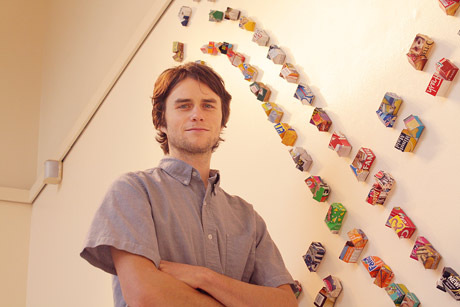Life in the cul de sac revisited
Gabriel Brown takes a new spin on life in the suburbs
The Advocate
Houses made of bright cardboard packaging sit in lines and rows and cul-de-sac circles to create isolated suburban communities on the white washed walls of the Visual Arts Gallery at MHCC.
In his exhibit, “Great Tasting Goodness,” Gabriel Brown holds a looking glass to suburbia, reflecting what gets consumed, what gets tossed out and what gets built.
The dumpster-diving artist said, “Garbage is really inspirational for me. Our waste is almost more evocative of who we really are than what we produce; what we don’t want says just as much about us. In a society like America, we have externalized so many areas of our life and the processes that keep us alive.
|
|||
We become disconnected from our waste, and part of who we are.”
Brown said he puts “hours and hours and hours and hours” into his work, including the crafted houses made of Marlboro, Starbucks and Great Tasting Goodness packaging. He acquires his recycled material from dumpsters, family, friends and coworkers.
“I’m making work about the suburbs, so I have to get the garbage from the suburbs,” he said.
As to what he found difficult in producing this exhibit, Brown said, “This work is all about suburbia. My friends and family live in the suburbs. So then I’m being very critical of my family and friends. Also, I’m taking a lot of pictures of the suburbs and I’m taking their garbage. So I’m invading. I don’t like to be invasive, but maybe I do. Maybe that’s a lie.”
Brown grew up in Spokane and went to Spokane Falls Community College before getting his masters of fine arts from Eastern Washington University and his bachelors of fine arts from Washington State University.
According to Nathan Orosco, Visual Arts Gallery coordinator, “(Great Tasting Goodness) is a traveling show, coming from the Museum of Arts and Culture in Spokane, Wash.,” one of Brown’s “favorite art spaces in the city.” Brown said, “It was personally significant for me. Many of my favorite regional artists have shown in that space.”
Brown received daily media coverage for his street performances. “I was out Mondays through Fridays, 8 a.m. sharp, panhandling in a business suit,” he said. He stood on the side of the road holding his briefcase and a new cardboard sign every day. “Need to get to Wall Street,” said one sign. “Can’t afford gas for my Hummer,” said another.
“I got 21 bucks, 72 cents, and a guitar pick,” said Brown about how much he made panhandling during his performances. But he said his performance was “about the message of it” as well as entertainment. He wasn’t sure how the panhandlers who begged just a block away would take it.
When asked by the homeless, “What are you saying?” Brown said, “I guess people are too materialistic,” and they “made friends.”
Brown’s multimedia work will be exhibited in the Visual Arts Gallery through Nov. 24. There will be a public reception Thursday from 11:30 a.m. to 1:30 p.m.
Go to www.gabrielbrown.net for video performances and more of the artist’s work.
![]()
The Advocate reserves the right to not publish comments based on their appropriateness.
![]()
Notice: Undefined variable: c5t_output in /hermes/walnacweb06/walnacweb06ac/b2874/moo.advocateonlinenet1/mhccadvocate/103009/AE_GabrielBrown.php on line 216
![]()

